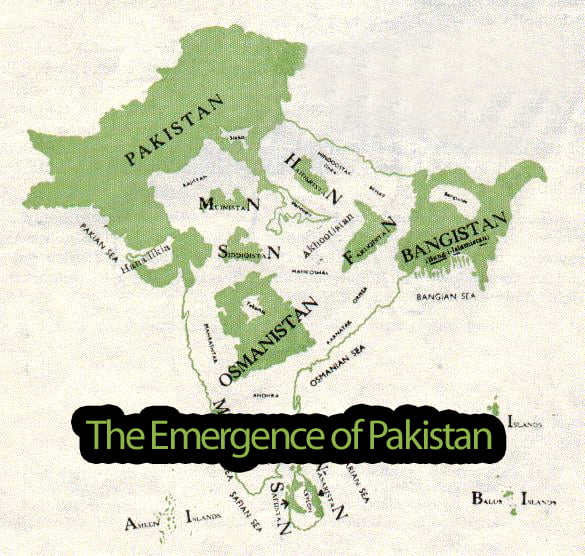The Emergence of Pakistan
Introduction
The reason to write this article to provide brief history of Pakistan, unfortunately unable to cover with one article, here started with Ancient Times and will be cover with new Technology Era in next article. The creation of Pakistan on 14th August 1947 was the culmination of the struggle that started in 1857 to achieve freedom from British domination over the Indo-Pak subcontinent. The British came to the subcontinent in the early seventeenth century as merchants and eventually became its rulers. They took the reign of the government by overthrowing the Muslims who had ruled the subcontinent for 650 years. Before the Muslims the Hindus dominated the political scene. Still earlier the Dravidian and the aboriginal tribes were the masters. Therefore a glimpse into the history of the subcontinent seems necessary in order to understand the creation of Pakistan.
The most popular book The Emergence of Pakistan by Chaudhry Muhammad Ali (Prime Minister of Pakistan, August 11, 1955), I really inspired by this book. I will suggest to all youth of Pakistan you’ve to must read the Chaudhry Muhammad Ali’s book The Emergence of Pakistan.
The Ancient Times
The history of Indo-Pakistan goes back to the stone Age. It was an age of hunting and gathering and towards its close rudimentary agriculture had started. This was followed by the Indus Valley Civilization, a period of well developed agriculture, trade and commerce, art architecture, cities and buildings, religion and rites. It dates back to 3000-3500 BC. Its collapse is still and unsolved mystery. The Dravidian Civilization followed the Indus Valley Civilization and might also have coexisted with it. It flourished over the major part of the subcontinent with well developed agriculture, religion and social institutions. The Dravidians had occupied a large part of the subcontinent by pushing the aboriginal tribes (Santal, Munda, Oraon, Bhil, Gond etc.) into the more difficult environment of hills and mountains.
The Aryans
The Aryans invaded the Indo-Pak subcontinent in the middle of the first millennium BC. They came from Central Asia and entered the subcontinent from the north-west. They first settled in Sapta Sindhu or the Seven Rivers from the Kabul to the Jumna. The Aryans continued their advance eastward and conquered a large part of the Ganges Plains and later crossed the vanquished were the Dasyus or Dasas (the dark-colored snub nosed slaves as the Aryans called them), i.e., the Dravidians and the aboriginal tribes.
The Aryans were pastoralists. They lived mainly on milk and meat. They worshipped natural phenomena like the sun, the moon, fire, wind, rain etc., but they also believed in one ultimate supreme God. The religious beliefs of the Aryans in association with those of the Dravidians led to the development of Hinduism.
It is a religion believing in many gods and a caste system. The caste is determined by birth and not by one’s achievements and accomplishments. By no means can a person belonging to one caste cross over to the other. The whole society is divided into four varnas (caste groups). The Barhmans (priests) are at the top and are followed by Kshtriyas (warriors/rulers), the Vaisyas (traders) and the Sudras (cultivators). All other castes are outside the varna. They are low castes. Some of them are “untouchable”. Water and food are polluted by their touch. The different castes do not intermarry and a number of them cannot interline. People belonging to other religions occupy a position below all the Hindu castes.
Hinduism spread over the major part of the subcontinent but the subcontinent has never remained one political unit. It was during the reign of the Mauryan King Asoka (250 BC) that the largest kingdom under the Hindus was established. It extended as far south as the Penner River. It is doubtful that Asoka remained Hindu throughout his life. The horrors of the war of Kalinga had so much disturbed him that he came under the influence of Buddha and might have actually embraced Buddhism.
The Hindu domination was not continuous. Buddha founded a religion in the sixth century BC. Buddhism was a strong reaction against the caste-ridden Hinduism. Buddhists established independent kingdoms in some parts of the subcontinent but they eventually lost their hold. Buddhism failed to survive against Brahmanism.
During Hindu rule the subcontinent continued to be intermittently invaded by armies marching from the north-west. The Sakas, the Parthians and the Kushans were some of the groups which came to the subcontinent and established empires. Some of them established extensive empires. The Kushans under Kanishka for example (first/second century AD) established an empire extending from Sinkiang to Varanasi (Benaras) with its capital at Purushapura (Peshawar).
continue…… Part II : The Emergence of Pakistan , Part III : The Emergence of Pakistan


hooray, your writings on theater and writing much missed!
Someone necessarily help to make severely articles I’d state. That is the first time I frequented your website page and thus far? I amazed with the research you made to make this actual post amazing. Fantastic job!
Cool blog you got here. I liked your post, but I have to say the entire blog doesn’t seem to display properly on my iPad. Other then that, keep it up!
This website is really good! How was it made .
Couldn’t have said it better myself.